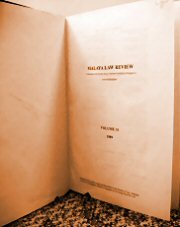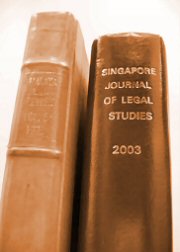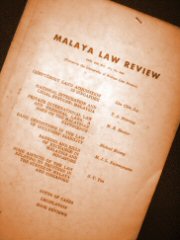|
Archive |
2386 records match your query:
| 341. | DECEMBER 2011 Issue | p.510 | |
| | Access to Court Records: The Secret to Open Justice
Vanessa Yeo • [2011] Sing JLS 510 (Dec)This paper concerns the legal framework governing non-party access to court records in Singapore. It provides a brief comparative study of the access frameworks in Australia and the UK. From this comparative analysis, guiding principles and procedures are distilled to facilitate suggestions on how Singapore's current access regime may be reformed. Open justice and the freedom of information and expression may be fundamental principles, but they do not mandate an unquestioned right of access to judicial records as the interests of justice may be served by both disclosure and non-disclosure. Both principles must be balanced against competing considerations, such as confidentiality and the right to a fair trial. An access regime is not built on open justice alone. It must adeptly reconcile all the competing factors in a manner which best secures the proper administration of justice.
| | 342. | DECEMBER 2011 Issue | p.533 | |
| | Rationalising the Procedure for Judicial Review in Singapore
Seow Zhixiang • [2011] Sing JLS 533 (Dec)This article makes two broad arguments in relation to the procedure for judicial review in Singapore. First, it argues against the traditional view that O. 53 of the Rules of Court is a separate and exclusive procedure, confined to its express provisions. The correct view should be that the other Rules of Court and the powers of the court are not excluded unless contrary to the express provisions of O. 53. Second, the article considers the effect of a little-noticed amendment which has expanded the scope of the Government Proceedings Act to include proceedings for judicial review against the Government. The practical effect of both arguments in relation to the procedure for judicial review is also discussed.
| | 343. | DECEMBER 2011 Issue | p.553 | |
| | Legislation and Case Comments: Revisiting the Similar Fact Rule in Singapore
Chen Siyuan • [2011] Sing JLS 553 (Dec)The similar fact rule in Singapore - as with the law on any evidence law doctrine that can be found in both our Evidence Act and the common law - has required clarification for some time. This note, which discusses the latest local decision on the similar fact rule, considers if that decision is compatible with the Evidence Act and the various conceptualisations underlying the doctrine.
| | 344. | DECEMBER 2011 Issue | p.564 | |
| | Legislation and Case Comments: En Bloc Sales and Joint Tenancy
Barry C. Crown • [2011] Sing JLS 564 (Dec)In Goh Teh Lee v. Lim Li Pheng Maria the Court of Appeal had to consider a novel point relating to the law of co-ownership. Mr. Goh was the joint tenant of a flat together with his then wife in a development which was the subject of a proposed collective sale. All the other owners of properties in the development, including Mr. Goh's wife, had agreed to the collective sale. In fact, Mrs. Goh had appended her signature to all the relevant documents relating to the sale. Mr. Goh had raised objections to the proposed collective sale before the Strata Titles Board and the High Court, both of which had rejected his submissions and had ordered the collective sale of the development. Mr. Goh appealed to the Court of Appeal seeking to reverse the order of the High Court.
| | 345. | DECEMBER 2011 Issue | p.570 | |
| | Legislation and Case Comments: Restitution for Victims of Fraud
Yip Man • [2011] Sing JLS 570 (Dec)The Court of Appeal decision in Scandinaviska Enskilda Banken AB (Publ), Singapore Branch v. Asia Pacific Breweries (Singapore) Pte Ltd raised many issues of law, including those of agency, banking, tort and restitution. This note will focus on the restitutionary issues. The Court of Appeal was put in a tough spot of having to balance the justice between two victims of fraud and this may have resulted in a decision that puts the law of unjust enrichment in a difficult position.
| | 346. | DECEMBER 2011 Issue | p.581 | |
| | Book Review: Codification, Macaulay and the Indian Penal Code: The Legacies and Modern Challenges of Criminal Law Reform by Wing-Cheong Chan, Barry Wright and Stanley Yeo, eds.
Chen Siyuan • [2011] Sing JLS 581 (Dec)As noted (at p. vii) by the contributors to this book, the Indian Penal Code 1860 (Central Act 45 of 1860) ("IPC"), largely the work of Thomas Macaulay, "was the first codification of criminal law in the British Empire and is the longest serving code in the common law world". Upon its enactment, the influential IPC was adopted in various British colonies, such as Singapore. The continuing use of legislation of such pedigree, however, brings about several problems. Any legislative inertia to update the statute from time to time will put the judiciary in a dilemma, whenever the latter is asked to either resolve newfound ambiguities and loopholes in the pro-visions, or interpret provisions in the context of evolving social norms. Lacking a democratic mandate, different judges will also have different conceptions of how much judicial activism can and should be accommodated.
| | 347. | DECEMBER 2011 Issue | p.584 | |
| | Book Review: The Law of Torts in Singapore by Gary Chan Kok Yew
Goh Yihan • [2011] Sing JLS 584 (Dec)The Law of Torts in Singapore is the first local torts textbook in Singapore. It is published under Academy Publishing's "Law Practice Series", which aims to build up a library of textbooks on important aspects of Singapore law. The present book is a prominent addition to that series. The book is divided into twenty chapters, with seventeen chapters written by Gary Chan Kok Yew, the book's stated author. Lee Pey Woan contributed two other chapters, and co-wrote one other chapter with the author. These twenty chapters cover the major torts, with an understandable concentration on the tort of negligence. Apart from negligence, the other chapters also cover intentional torts to the person, breach of statutory duty, interference with land, occupiers' liability, interference with goods, defamation, false representations, the economic torts, protection of privacy and malicious prosecution/misfeasance of public office. There are further chapters that deal with more "general" aspects of the law of torts, such as an introductory chapter discussing (in a more theoretical vein) the aims of the law of torts, as well as more doctrinal chapters discussing the various possible parties in a tort action, vicarious liability, and remedies. This is a comprehensive spread of coverage that is similar to other contemporary textbooks of this nature (see e.g., Carolyn Sappideen & Prue Vines, eds., Fleming's The Law of Torts, 10th ed. (Sydney: Lawbook Co., 2011). In the preface, the author states that the book's aim is "to provide a synthesis of the law of torts in Singapore by bringing together … a discussion of Singapore court decisions and statutes as well as reviews and commentaries on these developments, and by tapping on the deep reservoir of English and Commonwealth precedents" (at p. ix). As we shall soon see, the book more than meets this broadly stated aim.
| | 348. | DECEMBER 2011 Issue | p.588 | |
| | Book Review: Networks as Connected Contracts by Gunther Teubner
Goh Yihan • [2011] Sing JLS 588 (Dec)Networks as Connected Contracts is the seventh volume in the International Studies in the Theory of Private Law Series. This series of books "aims to investigate the normative and theoretical foundations of the law governing relations between citizens". The book under review was originally written in the German language by Gunther Teubner, and translated into the English language by Michelle Everson. Hugh Collins, who also provides a substantial introduction spanning some 72 pages, is the editor of the present book. The subject of the book is the business network, which is "a contractual network consist[ing] of a number of independent firms that enter a pattern of interrelated contracts, which are designed to confer on the parties many of the benefits of co-ordination achieved through vertical integration in a single firm, without in fact ever creating a single integrated business entity such as a corporation or a partnership" (at p. 1). The legal problem with business networks is that they do not fit neatly into recognised legal concepts and hence escape easy legal resolution. A paradigm example of a business network is the retail franchise: it is neither a bilateral contractual arrangement (since that ignores the interdependance of the separate franchise agreements), nor a company (since that ignores the general independence of the franchisees from the franchisor). Through the use of an approach known loosely as "sociological jurisprudence", Teubner advances the novel idea of "connected contracts", which he in turn uses to address the legal problems arising from business networks. This book is a synthesis and development of Teubner's earlier works on the same subject.
| | 349. | DECEMBER 2011 Issue | p.592 | |
| | Book Review: Trusts and Shared Property; Trusts, Credit Security andTrading by Tey Tsun Hang
Seow Fu Hong Colin • [2011] Sing JLS 592 (Dec)Equity, through the mechanism of the trust, may generally be thought to encompass a dualistic approach capable of resolving non-commercial shared property disputes through the use of either the resulting trust or the common intention constructive trust as alternative vehicles of remedy. In this monograph, the author addresses head-on this dualistic characteristic of equity-in-action by offering a broad-picture critique of the law in an effort to convince readers that the common intention constructive trust should prevail over the resulting trust as the preferred analytical vehicle whenever equity intervenes to resolve shared property disputes in non-commercial contexts.
| | 350. | DECEMBER 2011 Issue | p.596 | |
| | Book Review: Trusts and Asset Protection; Trusts and Forced Heirship by Tey Tsun Hang
Terence Tan Zhong Wei • [2011] Sing JLS 596 (Dec)The law of trusts today is an area of law which is characterised by fluidity and dynamism. This can be partially attributed to the modern tendency in equity to place more emphasis on the principles underlying detailed rules formulated in cases rather than on the rules themselves, treating these rules more like guidelines which a court can refer to in applying the principles.
| |
|
|


 |







